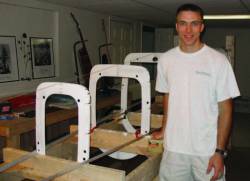GNSS Filtering Options
View equations 1-4
View Equations 5-13
Q: What are the differences between least-squares and Kalman filtering?
By Inside GNSS
View equations 1-4
View Equations 5-13
Q: What are the differences between least-squares and Kalman filtering?
By Inside GNSS Veth proudly poses with his RV-8A fuselage components securely fastened in a jig. The RV-8A is a two-place, tandem, experimental aircraft that is home-built from kit components. When completed, he plans to use the aircraft as an experimental navigation testbed.
Veth proudly poses with his RV-8A fuselage components securely fastened in a jig. The RV-8A is a two-place, tandem, experimental aircraft that is home-built from kit components. When completed, he plans to use the aircraft as an experimental navigation testbed.SIDEBAR: Mike Veth’s Compass Points
Over the course of Lt. Col. Michael Veth’s 20-year career in the U.S. Air Force (USAF), certain navigation technologies may have changed dramatically, but working toward increased accuracy has remained a constant.
By Inside GNSS One of 12 magnetograms recorded at Greenwich Observatory during the Great Geomagnetic Storm of 1859
One of 12 magnetograms recorded at Greenwich Observatory during the Great Geomagnetic Storm of 1859 1996 soccer game in the Midwest, (Rick Dikeman image)
1996 soccer game in the Midwest, (Rick Dikeman image)
 Nouméa ground station after the flood
Nouméa ground station after the flood A pencil and a coffee cup show the size of NASA’s teeny tiny PhoneSat
A pencil and a coffee cup show the size of NASA’s teeny tiny PhoneSat Bonus Hotspot: Naro Tartaruga AUV
Bonus Hotspot: Naro Tartaruga AUV
 Pacific lamprey spawning (photo by Jeremy Monroe, Fresh Waters Illustrated)
Pacific lamprey spawning (photo by Jeremy Monroe, Fresh Waters Illustrated) “Return of the Bucentaurn to the Molo on Ascension Day”, by (Giovanni Antonio Canal) Canaletto
“Return of the Bucentaurn to the Molo on Ascension Day”, by (Giovanni Antonio Canal) Canaletto The U.S. Naval Observatory Alternate Master Clock at 2nd Space Operations Squadron, Schriever AFB in Colorado. This photo was taken in January, 2006 during the addition of a leap second. The USNO master clocks control GPS timing. They are accurate to within one second every 20 million years (Satellites are so picky! Humans, on the other hand, just want to know if we’re too late for lunch) USAF photo by A1C Jason Ridder.
The U.S. Naval Observatory Alternate Master Clock at 2nd Space Operations Squadron, Schriever AFB in Colorado. This photo was taken in January, 2006 during the addition of a leap second. The USNO master clocks control GPS timing. They are accurate to within one second every 20 million years (Satellites are so picky! Humans, on the other hand, just want to know if we’re too late for lunch) USAF photo by A1C Jason Ridder.  Detail of Compass/ BeiDou2 system diagram
Detail of Compass/ BeiDou2 system diagram Hotspot 6: Beluga A300 600ST
Hotspot 6: Beluga A300 600ST

1. TIMING IS EVERYTHING
Washington, D.C.